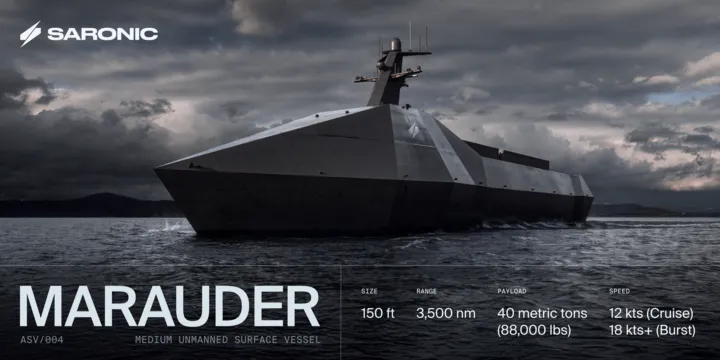Saronic acquires Gulf Craft to accelerate autonomous shipbuilding
Saronic, the US company that designs and manufactures autonomous surface vessels, has acquired Gulf Craft, a Louisiana-based company to accelerate its route to autonomous shipbuilding, according to a 17th April post on the company’s Medium account.
The newly acquired facility will serve as a manufacturing and prototyping hub for Saronic’s medium unmanned surface vessels (MUSV), including the 150 ft (45 metre) Marauder. “We don’t wait — we build for what our customers need, when they need it…this acquisition gives us the immediate capacity to meet urgent customer needs for larger autonomous vessels,” Saronic CEO, Dino Mavrookas said.
Adding Gulf Craft’s facility will eventually enable Saronic to build up to 50 autonomous vessels per year, “supporting both immediate MUSV development and production as well as capacity for significant expansion,” the Medium post states. It joins the company’s existing factory in Austin Texas, which produces smaller autonomous vessels up to 24 ft (8 metres). The acquisition will lead to an expansion of the Gulf Craft workforce, which Saronic has retained, with the expectation that 500 new roles will be created in support of the Louisiana facility by 2029.
In February, Saronic also announced that it had closed its Series C funding round, valued at $600 million (£460 mln/€554 mln), it intends to use some of that investment to build Port Alpha, which it describes as a “next generation facility” designed to build autonomous surface vessels at scale and pace for the US. That plan was initially slated as being the gateway to Saronic’s MUSV offering, however, the acquisition of Gulf Craft indicates that the company is planning to start prototyping and production at the same time as it locates a site for Port Alpha and initiates construction.
Gulf Craft’s facility on the Gulf Coast of America is nearly 100 acres (0.4 square kilometres), a LinkedIn page that appears to represent the company states that it has built custom aluminium boats since 1965 and employs 51 – 200 staff. The company builds commercial vessels like ferries and off-shore support boats. Saronic plans to invest more than $250 million in the facility which will be used to modernise the infrastructure and machinery there.
Saronic has positioned the acquisition inline with America’s national shipbuilding effort, which is struggling to keep pace with China’s and find new routes to counter the PRC’s growing numerical dominance in that field.
Tech profile: Marauder

Saronic unveiled the Marauder MUSV concept at the same time as announcing its acquisition of Gulf Craft. Credit: Saronic.
Saronic also unveiled its first MUSC concept, the 150 ft Marauder, which it states will have a top speed of 18 knots and a payload capacity of 39.9 tonnes enabling the vessel to travel up to 3,500 nautical miles (6,480 km). It will include Saronic’s existing autonomous capability, which employs artificial intelligence to enable mission-level autonomy. Its platforms can share data and fuse it into a single operational picture to support planning and swarm tactics, the company website states. We have already seen companies like Flarebright demonstrate dramatic improvements to navigation accuracy using sensor fusion from within a swarm, which is indicative of the types of mission outputs Saronic might be referring to here. The autonomous mission planning appears to include swarm tactics with the smaller autonomous vessels surrounding and attacking threats based on user-defined outcomes. Like most of the more advanced elements of defence production, Saronic also uses digital twins for its engineering and design process, which allows rapid changes to the platform design to be made without altering physical models.
Calibre comment
It is worth noting that China’s shipbuilding appears to focus primarily on conventional maritime capabilities. It is building submarines, aircraft carriers and surface combatants at a considerable rate, and relies on a variety of conventional surface combatants to patrol and secure its interests in the South China Sea, as has been noted by naval analyst, Alex Luck on X.com. This is important because there is a need for balance between small autonomous platforms and large conventional manned ones in all domains. They are designed to complement each other and work synergistically. This means that while mass-producing MUSVs and smaller autonomous vessels has value in offsetting China’s scale in conventional shipbuilding, it must be accompanied by a similar effort to expand the US’s own conventional fleets.
If you would like to learn more about autonomy and the systems that are shaping defence, consider signing up for the Calibre Defence newsletter via the Calibre homepage. The newsletter is released on a monthly basis and dives into a single topic each time. The April issue will focus on Russia’s Lancet family of loitering munitions, and May will discuss the trade-offs between cheap mass, and smaller numbers of boutique capabilities.
By Sam Cranny-Evans, published on 22nd April, 2025.

Sign Up for Updates!
Get insider news, tips, and updates. No spam, just the good stuff!






